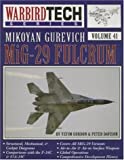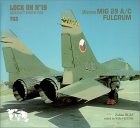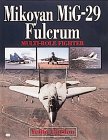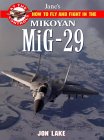| Country of Origin | CIS (Commonwealth of Independent States). |
|---|---|
| Similar Aircraft | F/A-18 Hornet, F-16 Fighting Falcon, F-15 Eagle, Su-27 Flanker. |
| Crew | One. |
| Role | Attack, counterair fighter. |
| Armament | Missiles, 30-mm gun. |
| Dimensions | Length: 50 ft, 10 in (15.6 m). Span: 33 ft, 7 in (10.26 m). |
MiG 29 Fulcrum WEFT Description
| Wings | Swept-back and tapered with square tips. LERXs are wide and curved down to the front. LERX begins on the nose below the mid-mount point, and the wings�’ trailing edges end at a high-mounted point. |
|---|---|
| Engine(s) | Twin jets are mounted low and to the sides of the fuselage. Diagonal-shaped air intakes give a box-like appearance. Large exhausts. |
| Fuselage | Long, thin, slender body with long, pointed drooping nose. High-mounted bubble canopy. |
| Tail | Fins have sharply tapered leading edges, canted outward with angular, cutoff tips. Flats are high-mounted on the fuselage, movable, swept-back, and tapered with a negative slant. |
Countries which Fly the MiG 29 Fulcrum
Belarus, Bulgaria, CIS (Commonwealth of Independent States), Cuba, Czech Republic, Germany, Hungary, India, Iran, Iraq, Malasia, Muldova, North Korea, Poland, Romania, Slovakia, Syria, Ukraine, Yugoslavia.
Books on the MiG 29 Fulcrum

Mig-29 Fulcrum: Mikoyan Gurevich
In the late 1960s the Soviet Union was working on a fourth-generation jet fighter concept. These aircraft would form the backbone of Warsaw Pact air forces in the next decade. The Soviet aerospace industry began considering enhancing combat capabilities with new air-to-air missiles and a sophisticated weapons control system. Thus the MiG-29 was born. High maneuverability, a high thrust-to-weight ratio, a wide speed range, and special short-range missiles are just a few of the MiG-29’s special characteristics. This book extensively covers the concept, variants, upgrades, carrier trials, service, sales, and what the future holds for the MiG-29. Find out how the MiG-29 paved the way for aerodynamic refinements, improved handling, stability, and technological changes that simplified the building process. Learn details on the MiG-29’s engine and controls. Powered by two Klimov NPP (Izotov) RD-33 afterburning turbofans rated at 5,040 kgp (11,111 lb st) at full military power, and armed with an internal gun, short- and medium-range air-to-air missiles, unguided rockets, and free-fall bombs, the MiG-29 is truly a marvel in military aircraft. Authors Yefim Gordon and Peter Davison use over 300 photos to illustrate the story of the MiG-29. Topics covered include design, development, structural detail, international production, trials, comparisons, overseas sales, and much more. This book is a must have for all aircraft enthusiasts!

Mikoyan MIG 29 A/C Fulcrum

MIG-29 Flight Manual

Mikoyan Mig-29 Fulcrum: Multi-Role Fighter
Developed to meet the Soviet Union’s requirement for a dual fighter and ground-attack aircraft, the MiG-29 entered operational service in 1983. With access to all design and production records, as well as declassified technical drawings and photos, Gordon has assembled the ultimate reference to this Cold War fighter, of which an estimated 500 are still believed to be in service around the globe.

Jane’s How to Fly and Fight in the Mikoyan Mig-29 Fulcrum: At the Controls
Jane’s At the Controls is a new series providing a ‘hands-on’ briefing of what it is like to fly and fight in modern combat aircraft. The MiG-29 was introduced by the Soviet air-force just as the Warsaw Pact began to break up. Armed with a new generation of air-to-air missiles and capable of astonishing maneuvers that can give it to the edge against most modern interceptors, the MiG-29 remains one of the best fighter aircraft in the world today.
